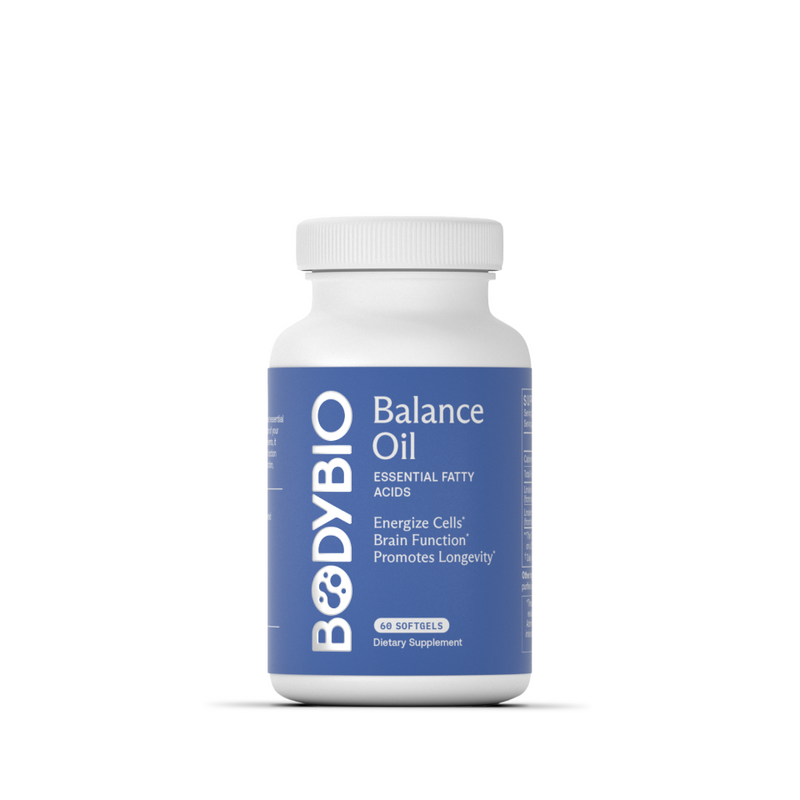Omega-3 vs. Omega-6 Fats: What They Are, Food Sources, & More
Authors:

Dr. Thomas Wnorowski
PhD, CNCC Research Director, BodyBio & Biomedical Nutritionist
Key Takeaways:
Key Points:
- Both omega-3 and omega-6 essential fatty acids are critical to our cellular health.
- The trick with both of these EFAs is to consume unadulterated, non-toxic, pure sources that support your health, not toxic versions found in processed foods and poorly manufactured supplements.
- The ideal omega-6 to omega-3 ratio for human health is 4:1 — you can keep this ratio in mind when choosing dietary healthy fats and supplements.
In today’s culture, the word “fat” still has negative connotations, largely due to the “low-fat” marketing movement. It’s important to recognize that not all fats are created equal — but they aren’t inherently evil. Omega-3 and omega-6 fatty acids, for example, are essential to our health. The types of fat you eat and the ratios you consume are key to optimizing your body’s physical and mental performance.
Let’s explore the benefits of omega-3 and omega-6 essential fatty acids, how to get them in your diet, the proper ratio of omega-6 to omega-3, and more.
Table of Contents:
- Types of Fatty Acids
- Omega-3 vs. Omega-6 Comparison
- Omega-3s: Types, Benefits, & How Much
- Omega-6s: Types, Benefits, & How Much
- Omega-3 & Omega-6 Foods
- Can Supplements Help?
Types of Fatty Acids
In the body, there are two main types of fats to know about — phospholipids (which contain a phosphate group and two fatty acid tails) and triglycerides (an ester plus three fatty acids).
Phospholipids are the tiny building blocks that automatically assemble into protective cell membranes surrounding every cell and many organelles, such as mitochondria. Triglycerides are the fats our body stores, the ones we typically regard as “bad.” If not burned for energy, carbohydrates are converted into triglycerides and stored as body fat.
Generally, shorter fatty acid chains are easier for the body to convert into energy, while longer and more complex fatty acid chains pose greater challenges:
- Saturated Fatty Acids (SFAs): The most stable of the fatty acids, these are plentiful in animal proteins such as butter, beef, eggs, chicken, and fish. The chemical structure of a saturated fat is a long, single chain of carbon atoms hooked together with a single bond. The hooks of single bonds make these fats saturated.
- Monounsaturated Fatty Acids (MUFAs): These include omega-9 fatty acids, the most well-known of which is oleic acid, found in olive oil. They have the same long carbon chain as saturated fats but also have one double bond. The double bond is the point of unsaturation, making the fat less stable.
- Polyunsaturated Fatty Acids (PUFAs): The least stable of all, including highly fluid fats like seed, nut, and fish oils. Instead of one double bond, polyunsaturated fats have the same long carbon chain as saturated fats and monounsaturated fats but with the addition of two or more double bonds.
However, instability doesn’t mean that PUFAs are bad for you. (This is a common misconception!) Two of the most important polyunsaturated fats in our diet are omega-3 and omega-6. In fact, they’re not just important — they’re essential. We simply have to be more careful with how we handle these delicate bioactive oils so they maintain their nutritional integrity, which is so crucial for our cellular health.
Omega-3 vs. Omega-6
Omega-3 and omega-6 fatty acids are essential polyunsaturated fats that play important roles in human health. They’re classified as essential fats because our bodies cannot produce them independently and need to get them from dietary sources. Despite both being crucial, they have distinct functions and sources.
Omega-3 fatty acids regulate the body's inflammatory response, which can be beneficial in conditions like heart disease, arthritis, and even cognitive decline.
Omega-6 fatty acids provide the body with energy and are involved in regulating cell function, metabolism, bone health, and the reproductive system.
What are Omega-3s?
Diving into the specifics a little more, omega-3 plays an integral role in cells throughout your body, especially the brain and heart. They trigger the production of hormones that help regulate heart and blood function, which can help mitigate the risk of heart disease and stroke.
Types of Omega-3 Fatty Acids
There are three common types of omega-3 fatty acids, which occupy different molecular levels:
- Alpha-linolenic acid (ALA) is the first level. It’s found in vegetables and plants, especially in nuts and seeds such as flax, hemp, chia, and walnuts.
- Eicosapentaenoic acid (EPA) and docosahexaenoic acid (DHA) are the second and third-level omega-3 fatty acids (also known as derivatives), meaning they can be metabolized from ALA.
EPA and DHA are both powerful nutrients with a wide range of functions that influence the brain, sensory organs, and synaptic and cardiac activity. Wild-caught, cold-water fish and caviar are excellent sources of EPA and DHA — but there is plenty of misinformation concerning fish oil benefits. Unless fish oil is carefully processed, it can do you more harm than good.
Omega-3 Benefits
Pure omega-3s have a variety of positive effects on our body, particularly when it comes to brain health. Some of the primary benefits from these fatty acids include:
- Improve mental health: Not only have studies from 2018 and 2021 backed up that those who consume omega-3s regularly are less likely to develop depression, but also that omega-3 supplements can improve symptoms in people who already are experiencing depression.
- Infant and childhood cognitive development: Studies have also shown that getting enough omega-3s during pregnancy leads to better cognitive development of the child, improved communication and social skills, and more.
- Decrease risk of heart disease: Fish-eating communities like those found in blue zones often have much lower rates of disease and cholesterol — we’ve since learned that this is likely due to the omega-3 fatty acids from fish in their diets.
- Reduce inflammation: Inflammation can be linked to nearly every chronic illness, but research has shown a clear connection between omega-3 supplementation and inflammation reduction.
How Much Omega-3 per Day?
The American Heart Association recommends adults consume at least 2 servings of fatty fish per week to get 250-500mg of combined EPA and DHA per day. However, it’s uncommon that people eat this much fish consistently, and this daily intake range is really the minimum of what is considered “enough.” For those with certain health conditions or who want a stronger foundation for brain health, it’s recommended to get even more than 500mg of omega-3s per day.
What are Omega-6s?
Omega-6 fatty acids are the predominant essential fatty acid family, and have a vast number of management functions throughout the body. They help regulate all cell signaling, boast the highest concentration of energy, and make up nearly 15% of red blood cell membranes.
Types of Omega-6 Fatty Acids
- Linoleic acid (LA) is the top-level omega-6 and is found in most nuts and seeds, such as safflower and sunflower, in addition to soy. It is vital to the function of the mitochondria by supporting cardiolipin, a phospholipid that plays an important role in energy metabolism.
- Gamma-linolenic (GLA), dihomo-gamma linolenic acid (DGLA), and arachidonic acid (AA), are the secondary downstream omega-6 fatty acids. Good sources of AA include egg yolks, animal proteins, and dairy products.
Omega-6 Benefits
These fatty acids primarily help with cellular health but have some overlap with omega-3 benefits. The most notable effects of omega-6 intake are:
- Weight loss: Studies have shown that a type of omega-6, conjugated linoleic acid, is linked to reduced body fat mass with supplementation of 3.2g per day.
- Reduce inflammation: Similar to omega-3s, recent research indicates that omega-6s might be able to reduce inflammatory processes and improve things like fatigue, depression, gastrointestinal issues, and more.
- Improve joint pain: Evening primrose oil, a therapeutic source of omega-6s, has been shown to reduce pain, swelling, and morning stiffness in those affected by joint pain.
How Much Omega-6 per Day?
Experts typically recommend a daily intake of at least 11-22g of omega-6s, which is further specified to 17g for men and 12g for women. For reference, a salad dressing with a tablespoon of pure safflower oil (like that in our Balance Oil) provides 9 grams of omega-6 fats.
Omega-3 to Omega-6 Ratio
There is a finite amount of space for EFAs in our cells, which means that omega-6 and omega-3 fatty acid families wind up competing against each other. Excess omega-3 will displace omega-6 — however, this is not true the other way around. Achieving the ideal 4:1 ratio of omega-6 to omega-3 is essential to optimizing cellular health.
While it may seem counterintuitive to give the upper hand to “inflammatory” omega-6s, these essential fatty acids are not the enemy. Yes, when heated, chemically treated, and oxidized, these omega-6s become toxic to your cells. But in their purest form, they are anti-inflammatory and crucial for cellular health.
There is a danger in consuming too many omega-3 fatty acids as well, a trend that BodyBio has observed in over 80% of red blood cell fatty acid tests (RBCFAs) that we perform every year. We need an optimal ratio of omega-6 and 3 for good health and wellbeing.
Omega-3 & Omega-6 Food Sources
So how should you go about achieving the optimal 4:1 ratio in your diet? Here are some common foods that contain omega-3s and omega-6s:
|
Omega-3 Foods: |
Omega-6 Foods: |
|
|
Source Your Seed Oils Carefully
Unfortunately, it’s not as simple as eating more of these foods. Consuming these vital fatty acids for health benefits comes down to purity and integrity. We have to be wary of the commercial food industry, where toxic and rancid products and aggressive marketing tactics are widespread.
Processing (heat, light, and chemical use) can alter the molecular structure of fatty acids and negate their health benefits. The biggest offender is touted as one of the best sources of omega-3 fatty acids — fish oil. Most commercial fish oils are processed using high heat for extraction, which degrades the fatty acids and leads to the formation of aldehydes (cousins of formaldehyde) that cause inflammatory responses in cells.
The same transformation occurs whenever you expose monounsaturated and polyunsaturated fatty acids to high temperatures, which includes almost all commercial oils you find in the supermarket, including olive oil, canola oil, sunflower oil, and so on. The greater a fat’s unsaturation, the greater its toxicity when heated. While there is no doubt that trans-fats are vile, toxic fatty acids are worse — and these are promoted as “heart healthy.”
A third related problem is dilution. The most notorious example is olive oil, 70% of which has been degraded with other oils such as sunflower, canola, and walnut. When shopping for olive oil, look for the highest quality organic extra virgin olive oil you can find. Extra virgin means it’s been cold-pressed from the first pressing of olives, so these will have the highest polyphenol levels and also the best flavor.
What to Look for
Ultimately, it’s the overprocessing of oils that renders them rancid. Consumption of these oils can have a negative impact on health and is the reason that omega-6 fats have been labeled as “disease-causing agents.” So then, you may be wondering, how do we know which fats are good and which are bad? Here are a few quick tips to help you remember what to look for and what to avoid:
- Shorter is better: Avoid fats with longer chains, such as mustard oil, canola oil, peanut oil, and peanut butter. These pose considerable challenges to the liver and the brain because of their size and are difficult to metabolize. Almond and cashew butter are good peanut butter alternatives (but still pay attention to how you feel when you consume them).
- Fast food is bad food: Most commercial food products already contain rancid MUFAs and PUFAs. The only thing worse is deep-frying them in more toxic oils, which changes the chemical constitution to something resembling diesel fuel. Yuck!
- Cook wisely: Coconut oil, animal fats, butter/ghee, and beef tallow are the safest to cook with, as they maintain their stability at high temperatures. Save the pure MUFAs and PUFAs for table oils, and remember, they should never be heated.
- Don’t rely on commercial fish oil: Focus instead on consuming whole, wild-caught fish from cold waters, such as salmon, sardines, and anchovies. You could also consider BodyBio Resolvin, which is carefully processed and cold-pressed, avoiding high temperatures and oxidation to maintain the integrity of these delicate essential fatty acids.
Can Supplements Make it Easier to Achieve Optimal EFA Levels?
You can support your health with omega-6 and omega-3 supplements, but make sure they’re manufactured by those who understand the science behind essential fatty acids. Our Balance Oil contains a pure mixture of organic and non-GMO safflower oil and flaxseed oil to deliver the optimal omega-6 to 3 ratio in one bottle. Together with essential vitamins and minerals, these additions to your diet will help to elevate EFA saturation on a cellular level and support your overall health.
Houtkooper, R. H., & Vaz, F. M. (2008). Cardiolipin, the heart of mitochondrial metabolism. Cellular and molecular life sciences : CMLS, 65(16), 2493–2506. https://doi.org/10.1007/s00018-008-8030-5
Su H, Liu R, Chang M, Huang J, Wang X. Dietary linoleic acid intake and blood inflammatory markers: a systematic review and meta-analysis of randomized controlled trials. Food & function. 2017;8(9):3091-103.
Vannice, G., & Rasmussen, H. (2014). Position of the academy of nutrition and dietetics: dietary fatty acids for healthy adults. Journal of the Academy of Nutrition and Dietetics, 114(1), 136–153. https://doi.org/10.1016/j.jand.2013.11.001.
EFSA Panel on Dietetic Products, Nutrition and Allergies (NDA); Scientific Opinion related to the Tolerable Upper Intake Level of eicosapentaenoic acid (EPA), docosahexaenoic acid (DHA) and docosapentaenoic acid (DPA). EFSA Journal 2012; 10(7):2815. [48 pp.] https://doi.org/10.2903/j.efsa.2012.2815.
Chae, M., & Park, K. (2021). Association between dietary omega-3 fatty acid intake and depression in postmenopausal women. Nutrition research and practice, 15(4), 468–478. https://doi.org/10.4162/nrp.2021.15.4.468.
Sánchez-Villegas, A., Álvarez-Pérez, J., Toledo, E., Salas-Salvadó, J., Ortega-Azorín, C., Zomeño, M. D., Vioque, J., Martínez, J. A., Romaguera, D., Pérez-López, J., López-Miranda, J., Estruch, R., Bueno-Cavanillas, A., Arós, F., Tur, J. A., Tinahones, F. J., Lecea, O., Martín, V., Ortega-Calvo, M., Vázquez, C., … Serra-Majem, L. (2018). Seafood Consumption, Omega-3 Fatty Acids Intake, and Life-Time Prevalence of Depression in the PREDIMED-Plus Trial. Nutrients, 10(12), 2000. https://doi.org/10.3390/nu10122000.
Su, K. P., Tseng, P. T., Lin, P. Y., Okubo, R., Chen, T. Y., Chen, Y. W., & Matsuoka, Y. J. (2018). Association of Use of Omega-3 Polyunsaturated Fatty Acids With Changes in Severity of Anxiety Symptoms: A Systematic Review and Meta-analysis. JAMA network open, 1(5), e182327. https://doi.org/10.1001/jamanetworkopen.2018.2327.
Liao, Y., Xie, B., Zhang, H., He, Q., Guo, L., Subramanieapillai, M., Fan, B., Lu, C., & McIntyre, R. S. (2019). Efficacy of omega-3 PUFAs in depression: A meta-analysis. Translational psychiatry, 9(1), 190. https://doi.org/10.1038/s41398-019-0515-5.
Sass, L., Bjarnadóttir, E., Stokholm, J., Chawes, B., Vinding, R. K., Mora-Jensen, A. C., Thorsen, J., Noergaard, S., Ebdrup, B. H., Jepsen, J. R. M., Fagerlund, B., Bønnelykke, K., Lauritzen, L., & Bisgaard, H. (2021). Fish Oil Supplementation in Pregnancy and Neurodevelopment in Childhood-A Randomized Clinical Trial. Child development, 92(4), 1624–1635. https://doi.org/10.1111/cdev.13541.
Zou, R., El Marroun, H., Voortman, T., Hillegers, M., White, T., & Tiemeier, H. (2021). Maternal polyunsaturated fatty acids during pregnancy and offspring brain development in childhood. The American journal of clinical nutrition, 114(1), 124–133. https://doi.org/10.1093/ajcn/nqab049.
Skulas-Ray, A. C., Wilson, P. W. F., Harris, W. S., Brinton, E. A., Kris-Etherton, P. M., Richter, C. K., Jacobson, T. A., Engler, M. B., Miller, M., Robinson, J. G., Blum, C. B., Rodriguez-Leyva, D., de Ferranti, S. D., Welty, F. K., & American Heart Association Council on Arteriosclerosis, Thrombosis and Vascular Biology; Council on Lifestyle and Cardiometabolic Health; Council on Cardiovascular Disease in the Young; Council on Cardiovascular and Stroke Nursing; and Council on Clinical Cardiology (2019). Omega-3 Fatty Acids for the Management of Hypertriglyceridemia: A Science Advisory From the American Heart Association. Circulation, 140(12), e673–e691. https://doi.org/10.1161/CIR.0000000000000709.
Elagizi, A., Lavie, C. J., O'Keefe, E., Marshall, K., O'Keefe, J. H., & Milani, R. V. (2021). An Update on Omega-3 Polyunsaturated Fatty Acids and Cardiovascular Health. Nutrients, 13(1), 204. https://doi.org/10.3390/nu13010204.
Kavyani, Z., Musazadeh, V., Fathi, S., Hossein Faghfouri, A., Dehghan, P., & Sarmadi, B. (2022). Efficacy of the omega-3 fatty acids supplementation on inflammatory biomarkers: An umbrella meta-analysis. International immunopharmacology, 111, 109104. https://doi.org/10.1016/j.intimp.2022.109104.
Khalili, L., Valdes-Ramos, R., & Harbige, L. S. (2021). Effect of n-3 (Omega-3) Polyunsaturated Fatty Acid Supplementation on Metabolic and Inflammatory Biomarkers and Body Weight in Patients with Type 2 Diabetes Mellitus: A Systematic Review and Meta-Analysis of RCTs. Metabolites, 11(11), 742. https://doi.org/10.3390/metabo11110742.
Zhong, X., Fang, Y. J., Pan, Z. Z., Li, B., Wang, L., Zheng, M. C., Chen, Y. M., & Zhang, C. X. (2013). Dietary fat, fatty acid intakes and colorectal cancer risk in Chinese adults: a case-control study. European journal of cancer prevention : the official journal of the European Cancer Prevention Organisation (ECP), 22(5), 438–447. https://doi.org/10.1097/CEJ.0b013e32835e88c4.
Whigham, L. D., Watras, A. C., & Schoeller, D. A. (2007). Efficacy of conjugated linoleic acid for reducing fat mass: a meta-analysis in humans. The American journal of clinical nutrition, 85(5), 1203–1211. https://doi.org/10.1093/ajcn/85.5.1203.
Sergeant, S., Rahbar, E., & Chilton, F. H. (2016). Gamma-linolenic acid, Dihommo-gamma linolenic, Eicosanoids and Inflammatory Processes. European journal of pharmacology, 785, 77–86. https://doi.org/10.1016/j.ejphar.2016.04.020.
Cameron, M., Gagnier, J. J., & Chrubasik, S. (2011). Herbal therapy for treating rheumatoid arthritis. The Cochrane database of systematic reviews, (2), CD002948. https://doi.org/10.1002/14651858.CD002948.pub2.



